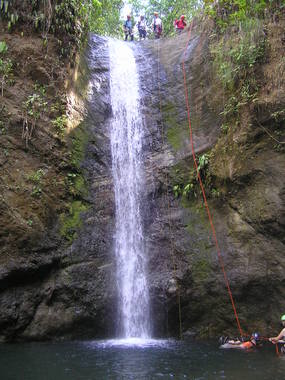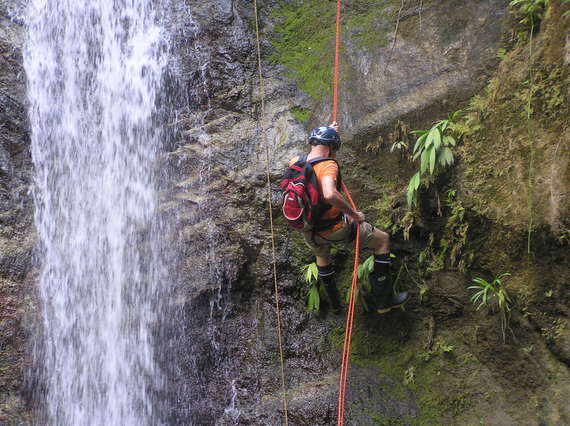While living in Costa Rica, I learned to rappel waterfalls from great heights. I overcame what I thought was an insurmountable challenge — my fear of heights.
When my husband and I went on our first rappelling trip, I was instructed on the techniques for gradually rappelling without having to plunge into the water from the precipice 110 ft up. Rappelling reduces the acceleration of gravity, thereby avoiding the crushing clash of two surfaces—one being part or all of the adventurer’s body and the other being the rocky pool below. Fortunately when done properly and with control, rappelling allows you to enjoy your surroundings during the gradual descent and exercises the brain by learning new techniques to be applied to the next rappelling experience.
Certainly, significant preparation is required. Our guides had rappel anchors with backups already in the trees at the top of the waterfall. Even so, they invested significant time and energy in retesting these anchors before our rappel. They also tested our knots, checked that the ropes were properly looped through our rappel devices and made sure that our ropes would not come into contact with any sharp objects during our descent for fear of their severing.
My rappel could only begin when I committed myself to angle my body 90 degrees so that I could walk on the wall face horizontally. This was extremely counterintuitive, but trying walk vertically as I was used to resulted in my body slamming into the wall face-first, very painfully.
The descent was controlled by grabbing the rope below my waste, not above. Since my body was hanging from the rope above, my natural inclination was to grab the rope hard above my waist with both hands to avoid a fall. Of course, this would only scour my hands raw, before I fell anyway. Truly, there is no strong grabbing required. Rather, lifting the hand outward away from the waist speeds up the descent and bringing that hand downward below the waist slows it.
Rappelling waterfalls is exhilarating on so many levels. First, realizing that slanting my back flat horizontal to the ground 110 feet below actually was safer was a thrilling paradigm. Then, walking a wall of orchids, mosses, insects, and other wonders gave the feeling of exploring uncharted territory. The brake hand is a fantastically unreasonable anomaly as well. That is, to completely stop and dunk my head in the waterfall or examine a plant by lowering one hand was complete defiance of natural laws.
Finally, arriving at the bottom of the rock face and seeing the wall above was organically awe-inspiring in that an otherwise unconscionable route was taken in a methodical, controlled manner. The unconventionality of the experience was a rush, even though there was never any true danger given the safeties in place.
Getting There
Likewise in executive coaching, I have clients hurtling themselves toward a goal. They want to get “there” no matter what. Then there are the adrenaline junkies who enjoy the risk of chaos, taking pride in not needing methods and plans. Oblivious to going slow to go fast, they miss that the scenery on the road to accomplishment can be half the wonder. Finally, an intense over-fantasization of the end result to instinctively drive themselves toward their goal results in disappointment in the end.
Several clients come to me having reached pinnacles in their professional lives to way to me, “what’s next?” The issue is that this is their entire roadmap to getting to their goal — that is, not having one.
They skip the essential self examination of strengths and weaknesses. What’s more, they pass over the assessment of risks and points of resistance with contingency plans to deal with them. This is not to say that they are not good leaders. They obviously achieved some level of success using these very techniques — but at what cost? There are more elegant, healthy, and enjoyable paths to their goals.
Going slow to go fast assures success. My clients’ willingness to study the past and sit with an experience to truly understand who they are makes them ever more effective leaders.
Horizontal Leaders
Specializing in women’s leadership, I continuously see another parallel to rappelling. Women integrating work with raising a family must manage day-to-day small wins rather than hurtling toward one or two large goals. Operating effectively in a space of attempting daily accomplishment based on the growth of those around them while not necessarily navigating vertically, per se, these women learn to effectively excel as horizontal leaders.
In business, horizontal leaders have an ability to lead networks of people who are not in their power domain. Horizontal leaders guide networks of people outside of their span of influence. They effectively persuade, uncover alternate paths, are true partners and collaborators, and walk in others’ shoes with emotional intelligence and empathy. This is invaluable in circumstances where the leader must rely more on influence than authority and where one must lead beyond traditional organizational boundaries. The skills that they develop along this path are key success factors for any organization.
The choice to raise families and pursue careers creates leaders inclined to excel horizontally. Operating from the mindset of employing a vertical route can create frustration and dissatisfaction. It seems impossible to be a spouse, caregiver, and have a fulfilling career. Yet, a direct route mindset is often self-imposed and unrealistic, disempowering many of my clients.
Can you embrace an otherwise direct route to take it methodically, in control, and efficiently?
1. Moving with Intention: As you navigate the goal, deliberately stop to calculate your next move and stay present to why you are managing the steps in your path. Moving with intention makes you less likely to be impatient with yourself and others.
2. Redirecting and Repositioning: No matter how slippery the rock face—or problem—there are techniques to stop a fall and anchor yourself until you are capable of planning your next move. Find what techniques work for you. Stop for as long as it takes to get acquainted with those techniques so you don’t lose control of your pace and trajectory.
3. Soaking Up Your Surroundings: Allow the experience to pour over you. Take moments to bask in your successes. Journal your successes and failures in reaching a particular goal. Soak up every ounce of the experience and learn!
4. Engaging Others In Your Success: Rappelling is not a one-person endeavor. You have a trusted partner supporting your journey and celebrating with you at the bottom. When you slip or lose your grip, have someone there to get you back on track and measure your pace.
As I rappelled, I learned new techniques in grip and control as I navigated a rarely touched landscape. Sometimes I found I was slipping on the mossy rocks, and I needed to use irregular methods — the belay — to slow my uncontrolled descent, always aware of the end goal.
Along the way I had my own personal experience. Crossing through the waterfall, stopping to embrace the incredible experience rejuvenated me and prepared me for the next step. Reaching my goal methodically was enjoyable and empowering.
“How a person masters his fate is more important than what his fate is.” - Karl Wilhelm von Humbold
Enjoyed this article? Check out The Success Principles of Breaking Boards Bare-Handed.
This article originally appeared on Huff Post Dec 06, 2017
Want exclusive tips sent to your inbox?
Sign up here to receive articles and updates from Laura Berger.


